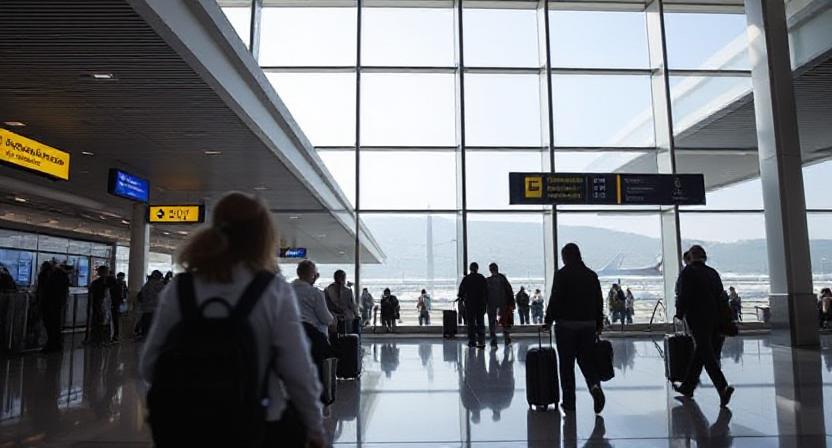Published on
October 20, 2025
Greece’s air industry is still robust in 2025, with steady growth in passenger traffic at the nation’s airports. The most recent statistics from the Hellenic Civil Aviation Authority (HCAA) and Hellenic Aviation Service Provider (HASP) reveal that Greece’s airports received 68.2 million passengers between January and September 2025. This is a 4.5 percent year-over-year growth from 65.3 million passengers in the same period of 2024. This rise indicates that both foreign and domestic travel demand in Greece is strong, as the nation continues to bounce back from worldwide disruptions and retains its position as a top travel spot.
Growth in Aircraft Movements Reflects Strong Demand
In tandem with the rise in passenger numbers, aircraft movements at Greece’s airports also experienced growth. A total of 511,044 flights were recorded between January and September 2025, reflecting a 3.7 percent increase from the same period in 2024. This surge in flights indicates a continued strong demand for both international connections to Greece’s main hubs and domestic air travel throughout the country, as well as growing regional connectivity.
Athens International Airport: A Major Contributor to the Growth
A significant contributor to the growth in passenger traffic is Athens International Airport (AIA), which continues to set records. During the first nine months of 2025, the airport handled 26.19 million passengers, marking a 6.7 percent increase compared to the same period in 2024. The capital city’s main gateway remains the busiest airport in Greece, welcoming both international and domestic travelers.
The surge in international traffic at Athens Airport is especially noteworthy, with an 8.5 percent increase in international passenger numbers, reaching 18.72 million. Domestic air travel also saw an increase of 2.2 percent, with 7.47 million passengers flying within Greece. In September 2025, Athens Airport handled 3.48 million passengers, a 5.4 percent increase from the same month last year, indicating the ongoing appeal of Greece as a year-round destination.
The continued growth at Athens International Airport signals its importance as a hub for travelers both within Europe and from across the globe. Its ability to handle record passenger numbers, even during the off-peak months, is a testament to the airport’s infrastructure and its integral role in Greece’s broader aviation and tourism sectors.
Strong Performance at State-Managed Airports
In addition to Athens, Greece’s 24 state-managed airports also experienced a significant uptick in passenger traffic. These airports collectively handled 10.79 million passengers from January to September 2025, a 6.4 percent increase from 10.14 million in 2024. This growth highlights the continued demand for air travel to regional and island airports, which serve as key entry points for both international and domestic tourists.
The Heraklion Airport on Crete is one of the standout performers, handling 1.47 million passengers in September 2025, a 4.2 percent increase compared to the same month last year. Crete’s popularity as a tourist destination remains strong, with Heraklion serving as a key access point for visitors arriving to explore the island’s rich history, beautiful beaches, and charming towns.
Regional Airports Manage Increased Traffic
The performance of Fraport Greece’s 14 regional airports is also noteworthy, as they continue to see growth in passenger traffic. In September 2025, these airports collectively welcomed 5.5 million passengers, marking a 2.8 percent increase compared to the same month in 2024. The continued growth of regional air travel signals that tourism demand is spreading beyond the traditional summer peak, as travelers seek year-round opportunities to visit Greece’s islands and regional destinations.
For the first nine months of 2025, Fraport Greece airports collectively handled 31.78 million passengers, a 2.6 percent year-on-year increase. This demonstrates that Greece’s smaller airports are becoming increasingly important in managing traffic as international visitors explore areas outside of the major metropolitan hubs. Corfu, Santorini, Mykonos, and Rhodes remain among the most popular destinations, drawing significant international and domestic flight traffic throughout the year.
The expansion of services and the growing popularity of Greece’s regional airports have positioned them as crucial players in the country’s aviation growth. With continued investment in infrastructure and expanded flight options, these regional airports are expected to support a growing number of visitors in the coming years, further enhancing the tourism experience throughout the Greek islands.
Looking Ahead: Continued Growth for Greek Airports
As the year progresses, Greece’s aviation sector is on track for continued growth. The rise in passenger traffic, particularly at Athens International Airport and regional airports managed by Fraport Greece, underscores the global appeal of Greece as a travel destination. The steady demand for international flights to and from Greece, as well as the ongoing popularity of domestic routes, is expected to drive further growth in the country’s aviation infrastructure in 2025 and beyond.
With the addition of new flight routes and the expansion of existing services, Greece is positioning itself as a key gateway to both Southern Europe and the Balkans. The country’s airports, backed by efficient operations and growing tourism demand, are set to handle increasing passenger volumes in the coming years.
Greek Aviation’s Role in Sustainable Tourism
Greece also emphasizes sustainable tourism, and its air transport industry is integral to this effort. The increasing number of international flights into Greece, as well as the increased frequency of local flights, underscores the nation’s commitment to enhancing air links while increasing sustainable practices in the tourism sector. The nation’s initiatives towards creating sustainable travel alternatives, including carbon offsetting and sustainable aviation initiatives, will enhance its credentials as a green tourism destination. Greek airports will help in sustaining the equilibrium between economic gains due to enhanced passenger traffic and the ecological stewardship associated with such development.
